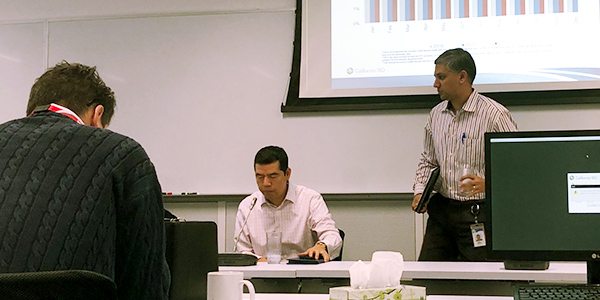By Hudson Sangree
FOLSOM, Calif. — CAISO’s efforts to rein in congestion revenue rights insufficiencies seemed to show progress this summer and early fall but fell short in the last months of 2018, the ISO reported Tuesday during its quarterly Market Performance and Planning Forum.
Historically CRR revenues have been inadequate to meet payouts, Guillermo Bautista Alderete, CAISO’s director of market analysis and forecasting, told meeting attendees at ISO headquarters.
That changed in the middle of this year because of high levels of summer congestion, he said.
“From July to October we actually flipped the condition, especially in July and August,” when there were significant surpluses, Bautista Alderete said. A graph he displayed showed a surplus in July of about $15 million and close to $40 million in August, which amounted to about 140% of revenue adequacy. Those figures did not include auction revenues.
The good news turned grim in November, when “we had insufficiency in the range of 80%,” he said. “Even if we account for auction revenues, we were still marginally short.”
The chronic shortfall in CRR revenues, leaving ratepayers footing the bill, has been an ongoing problem for CAISO. This year the ISO sought FERC’s approval for changes it hoped would help in 2019, but the commission was loath to give it everything it wanted.
In September, FERC rejected a CAISO plan to eliminate full funding of CRRs and instead scale payouts to align with revenue collected through the day-ahead market and congestion charges. (See FERC Rejects CAISO Congestion Revenue Scaling Plan.)
In October, the ISO asked FERC for expedited review of a revised proposal to protect electricity ratepayers from funding shortfalls. (See CAISO Modifies CRR Plan, Seeks Quick Approval.)
CAISO noted in its filing that CRR revenue shortfalls have continued into this year, and it urged the commission to quickly approve the revised plan to relieve ratepayers from paying costs for fully funding CRRs in 2019.
The ISO’s Department of Market Monitoring has estimated that CRR revenue shortfalls, which are allocated based on power consumption, cost California ratepayers about $100 million a year.
In November, FERC OKs CAISO Plan to Deal with CRR Shortfalls.)
“We agree with CAISO that the proposal reasonably distributes the burden resulting from congestion revenue insufficiency and will help improve the revenue insufficiency and auction revenue shortfall,” FERC said. “Rather than relying solely on [load-serving entities] to make whole CRR holders in the event those obligations are revenue insufficient, CAISO’s proposal distributes the burden to all CRR holders.”
Other results reported at Tuesday’s meeting included a stabilization in Western Energy Imbalance Market prices after a big spike at the end of July caused by high summer demand.
“As we have passed those summer months, the prices are generally stable,” Rahul Kalaskar, CAISO manager of market validation analysis, told those gathered and on the phone.






